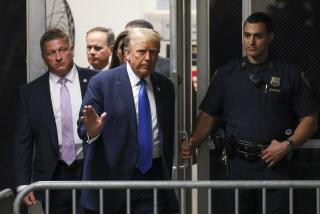Goldman Sachs agrees to settle SEC fraud case for $550 million
Reporting from Los Angeles and Washington — The $550-million deal between Goldman Sachs Group and federal regulators to settle the highest profile fraud case stemming from the financial crisis gave each side a measure of what it desperately needed.
The government finally had an answer for critics who say Washington has been too soft on Wall Street. And Goldman Sachs could get on with making money, paying a fine that it can easily afford.
Thursday’s settlement with the Securities and Exchange Commission came as Congress passed the most significant financial reform in decades — legislation designed to prevent the type of abuses Goldman was accused of. With the law, President Obama declared a new era of oversight for the financial industry.
Goldman agreed to pay $550 million to resolve allegations that the company misled investors who bought subprime mortgage-related securities created by Goldman. Although Goldman neither admitted nor denied wrongdoing, it made a rare concession that its marketing materials for the securities had been “incomplete,” which it acknowledged was a “mistake.”
“It is a major victory for the SEC because you don’t find other settlements in which the defendant admits it made materially misleading disclosure,” said John Coffee, a Columbia University securities-law professor. “This is one where they really bet the farm on this case by taking on the most esteemed firm on Wall Street, and they obtained a concession by Goldman that they misled their clients.”
Still, the penalty equals 4% of Goldman’s $13.4-billion profit last year. Moreover, investors concluded the settlement was worth much more to Goldman than it would pay.
The deal sent the investment bank’s stock price up nearly 10% in a surge that began on rumors late in Wall Street’s regular trading session Thursday and continued in the after-hours market after the settlement was announced. The combined increase added more than $6 billion to the firm’s total stock market value.
In a statement, Goldman called the settlement “the right outcome for our firm, our shareholders and our clients.”
The company also sought to assure investors that it wasn’t facing a cascade of SEC cases related to other mortgage-securities deals the bank sold during the heyday of the housing boom.
The case dealt with Goldman’s creation of a complex security whose value depended on the performance of bonds backed by subprime mortgages. But the bank did not tell the institutional investors who bought the security that the underlying bonds were selected with input from a coveted client — hedge fund Paulson & Co. — that was betting that the subprime market would collapse and cause the bonds to plunge in value.
Paulson & Co. paid Goldman a $15-million fee but made $1 billion, the SEC said, while investors who bought the mortgage-related securities lost $1 billion. Their losses were almost immediate. Less than a year after the securities were issued, 99% had been downgraded by credit-rating firms.
For Goldman, the settlement extricated the company from an embarrassing public imbroglio that had further tarnished a once-sterling reputation that already had been sullied by the global financial crisis. It also allowed all of Goldman’s high-ranking executives to retain their jobs.
“Goldman needed to put this behind them,” said Robert A. Mintz, a former federal prosecutor who is now a partner with McCarter & English in Newark, N.J. “They had to begin to rehabilitate the image of the firm and this is the first step in that direction.”
Though the settlement amount may seem low compared with Goldman’s financial heft, securities lawyers noted that the deal must be approved by a federal judge, who will weigh the size of the penalty against the gravity of the case rather than against Goldman’s earnings power.
“The judge has to approve that it’s appropriate,” said Pravin Rao, a former SEC enforcement branch chief and federal prosecutor who now is an attorney at Perkins Coie in Chicago.
What’s more, Goldman might have balked at a much larger penalty, and could have taken its chances by going to trial.
Given the extremely complex nature of the securities, “it’s a tough case,” Rao said. “The SEC could have gone to trial and lost, and got nothing.”
The SEC endured a firestorm of criticism when it launched the lawsuit in April, with critics attacking it as a thinly guised effort to benefit the Obama administration’s financial overhaul, which was stalled at the time.
“It’s a hell of a settlement,” said James Cox, a Duke University securities-law professor. “We clearly have the small David prevailing over the large Goliath.”
The settlement amount is the largest ever for a Wall Street firm in an SEC case, but ranks third among all SEC settlements with companies. The largest amount — $800 million — was paid by insurance giant American International Group in 2006 to settle allegations that the firm misstated its financial results.
Two years later the federal government stepped in to rescue AIG when the firm nearly collapsed because of investments gone awry.
“Today’s settlement sends positive message of deterrence and accountability,” said the SEC’s director of enforcement, Robert Khuzami.
Goldman shares jumped $6.16 to $145.22 in the final half hour of trading as the rumor of a settlement spread. The broader market also got a lift, with the Dow industrials closing off fractionally after being down about 95 points.
Of the $550 million the firm will pay, $250 million will go to harmed investors and $300 million will go to the Treasury.
The settlement does not affect the SEC’s ongoing suit against Goldman Vice President Fabrice Tourre, the only individual accused in the case. The the bank has agreed to cooperate with the agency with regard to that litigation.
More to Read
Inside the business of entertainment
The Wide Shot brings you news, analysis and insights on everything from streaming wars to production — and what it all means for the future.
You may occasionally receive promotional content from the Los Angeles Times.










